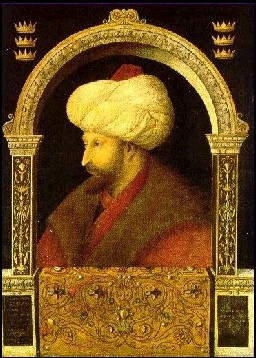 |
 |
| A.7.a. | The Conquest of Constantinople (1453) | |
The conquest of Constantinople had always been a matter of vital concern for the Ottomans as it was in the centre of their dominions, meaning the empire could never be fully integrated without it. It also gave refuge to the Ottomans’ enemies and was a main instigator of Crusades against them. However, in the last days of the Byzantine empire, Constantinople was like a head without a body! It was a poor and largely depopulated city of ruins, and the inhabitants continued to flee in the face of the Ottoman threat.
The young Sultan Mehmed also needed a great victory in order to reaffirm his new power and thus in April 1453 he began to lay siege to the Byzantine capital. The siege lasted 54 days (until 29 May 1453): the emperor Constantine XI Palaeologus rejected Mehmed’s terms of surrender so in accordance with shari’a he ordered a general assault and pillage. He named his new capital ‘Istanbul’ which is though to be a corruption of the Greek ‘estin poli’, ‘in/to the city’. This conquest turned Mehmed overnight into the most celebrated Sultan in the Muslim world and he began to see himself as heir to a world-wide empire: the thirty years of his reign established the distinctive character of the Ottoman empire.
| A.7.b. | Reconstruction of Istanbul: | |
Mehmed attempted to repopulate the city by the forcible settlement of people there from all over the empire, and by reinstating the Greek and Armenian Patriarchs and the Jewish Chief Rabbi, ensuring that they all reside in his capital; he also encouraged Jews to come from as far away as Germany and Italy. He repaired the roads and bridges leading to Istanbul, and in 1455 issued instructions to build a Grand Bazaar and repair the aqueducts to ensure the supply of water to the capital. He built his first palace, the Eski (‘Old’) Saray, in the centre of the city, but then built another, the ‘Yeni’ (‘New’) Saray, later changed to Topkapi Saray (‘Palace of the Cannon Gate’), which was completed in 1464.
Waqfs (pious foundations) played a primary role in the reconstruction of Istanbul as they insured the performance of a variety of public services such as the construction and maintenance of mosques, trading premises, lodgings for travellers, fountains, baths, bridges, schools and hospitals. These waqfs were under close official control: at the accession to the throne of each new Sultan, all the waqfiyyas were checked and either confirmed or cancelled; pious foundations set up by Christians were subject to the same control. For example, in 1528 waqfs in Anatolia were charged with the up-keep of 45 almshouses for the poor and travellers, 342 Friday mosques, 1095 smaller mosques, 110 medreses, 626 dervish convents, 114 schools for children, 75 caravanserais and 238 bath-houses. By the 1530s Istanbul had become a city of almost 1 million.
| A.7.c. | Development of an Imperial Code: | |
This building programme was accompanied by the codification, for the first time, of Ottoman imperial practice, laid down by Mehmet in a Qanun-name. There was a significant change in the structure of Ottoman court protocol, and the Sultan became increasingly secluded from his subjects, holding private receptions instead of public audiences. A special reception hall was built at Topkapi Saray, which was itself secluded from public eyes by the construction in 1478 of massive outer walls. Eventually, silence became a feature of court life: only three favoured pages were allowed to speak to Süleyman, and the rest had to use a sign language called isharet.
| A.7.d. | Development of Centralised Administration: | |
It was under Mehmed that the Ottoman empire developed a centralised absolutist administration. He eliminated all the elements which could have resisted him: for example, he suppressed with a heavy hand a revolt of the Janissaries, the army corps which was recruited from non-Muslim families at an early age, and given superior education which allowed them to rise to the most important administration posts. Having dealt with this revolt, he increased their pay, improved their weapons and doubled their numbers (from 5,000 to 10,000), making them the nucleus of the Ottoman army. Their commanders were chosen personally by the Sultan, and they took orders directly from the capital: thus in the provinces, the Janissaries represented the central authority of the Sultan. Furthermore, Mehmed chose all his ministers from among his personal slaves so that the Grand Vizier became an obedient instrument of the Sultan’s commands rather than a controller of the state himself, as he had been until the time of Murad II.
| A.7.e. | War with Venice and the beginning of Naval Supremacy: | |
In the early years of Mehmed’s reign, the Venetians and Genoese had obtained privileges to trade freely in the Aegean and Crimea on condition of payment of tribute (amounting to a recognition of Ottoman suzerainty). However, war with Venice began in 1463, lasting until 1479; envoys were exchanged between Venice and Uzun Hasan, ruler of the Ak-Koyunlu dynasty in Persia, with a view to an alliance, which was achieved in 1472 between Venice, Cyprus, the Knights of St John on Rhodes and Uzun Hasan. Mehmed was faced with danger on all sides and mobilised his entire army (c.70-100,000 men) and routed Uzun Hasan at Bashkent (eastern Anatolia).
Peace was made with Venice in 1479, and their freedom to trade was restored: the significance of this was that Mehmed had defeated the strongest naval power in the Mediterranean, and making him the undisputed master of the Straits. Next he succeeded in extending Ottoman mastery over the Black Sea; in 1475 the khanate of Crimea became an Ottoman vassal state but when Mehmed died in 1481 (aged 49) he left expeditions in Egypt, Italy and the Mediterranean unfinished. He was described by a contemporary historian as the ‘Master of Two Seas and Two Continents’.